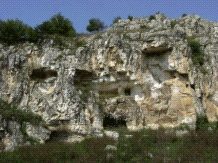

Still in the early Christian period along the river Suha Reka in Dobrogea arises a caved monasteries colony.
It is located near the fortresses of antiquity near villages Golesh, Silistra, Balik and Onogour village (municipality of Tervel) in the border areas between the municipality Dobrichka and Tervel. Colonia stretches along 40 km of the dry river valley, the southernmost point being in Hitovo village (municipality Dobrichka) and the north – in Golesh village (municipality Kaynardja). As a center of monastic life are accepted the caved large monastery, known as Gyaur Evleri, near Kragulevo village (village Dobrichka) and group of the fortress caved monasteries to Balik village. To the south and north of the this are located its subsidiaries, cells and churches.
Supposedly, in this case, it is about some of the oldest caved monasteries in Bulgaria and not only the Balkans, but in Europe. Their early refers to V-VI centuries and their end – the early century XI. The latest data are suggested by some designs and signs (especially in IYI sign around his cave monastery Hitovo). This assumption is confirmed by the findings of ancient fragments of old Bulgarian dishes in the late eleventh century to the early century XI during excavations in the cave complex “Gyaur Evleri”.
Caved Monastery “Gyaur Evleri”, near Balik village is situated on the right bank of the river Reka Suhata. Some researchers show it as the largest caved monastery in early fifth-century Byzantine-VI in Bulgaria.
The monastery complex is located on three levels and includes the church, chapel, and a large caved room abbot living in common. Church is carved with catolicon central nave, square-shaped, with a length of 3.10 m and a height of 1.90 m. On the eastern wall is formed altar with three sides. A corridor leads to the great caved room for all monks, that was carved with a water fountain. The church has a square nave and apse a rectangular chapel. North of the chapel is a dining room and abbot. The monastery is reused in sec. X, which tells us ceramic foothills and several inscriptions in Cyrillic. North of the monastery there are two cells removed and church-grave “Sandaklara Maariv” for monks’ funeral.
